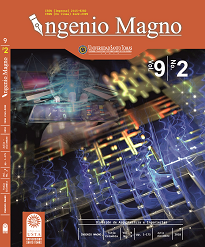Biomechanical analysis of the execution technique in the start of track cycling between semi-professional and amateur sportsmen
Main Article Content
Abstract
Downloads
Article Details
DECLARATION OF ORGINIALITY OF SUBMITTED ARTICLE
With this document, I/We certify that the article submitted for possible publication in the institutional journal INGENIO MAGNO of the Research Center Alberto Magno CIIAM of the University Santo Tomás, Tunja campus, is entirely of my(our) own writing, and is a product of my(our) direct intellectual contribution to knowledge.
All data and references to completed publications are duly identified with their respective bibliographical entries and in the citations thus highlighted. If any adjustment or correction is needed, I(we) will contact the journal authorities in advance.
Due to that stated above, I(we) declare that the entirety of the submitted material is in accordance with applicable laws regarding intellectual and industrial property, and therefore, I(we) hold myself(ourselves) responsible for any complaint related to it.
If the submitted article is published, I(we) declare that I(we) fully relinquish publishing rights of the article to the University Santo Tomás, Tunja campus. As remuneration for this relinquishment of rights, I(we) declare my(our) agreement to receive two (2) copies of the edition of the journal in which my(our) article appears.
References
B. McLean. D. and Parker A.W. (2009) An an-thropometric analysis of elite Australian track cyclists. J. Sports Sci., vol. 7, no. 3, 247–255.
Burke E. (2003) High-Tech Cycling. The scien-ce of riding faster. 2 Ed. Editor Edmund R. Bur-ke. University of Colorado at Colorado Sprongs. Recuperado el 3 de julio de 2018, de https://books.google.com.co/books?id=msdT4iQ-50cgC&printsec=frontcover&hl=es#v=o-nepage&q&f=false
C Candotti, Ribeiro T., J., Soares D. P., De Oli-veira Á. R., Loss J. F., and Guimarães A. C. S. (2007) Effective force and economy of tria-thletes and cyclists. Sport. Biomech., vol. 6, no. 1, 31–43
Cordeiro I. (2005). Biomecanica do ciclismo. Trabajo de Grado de Educación Física y Cien-cias del Deporte. Pontifícia Universidad de Ca-tólica do Rio Grande do Sul, recuperado 3 de julio 2018, de http://esportes.universoef.com. br/container/gerenciador_de_arquivos/arqui-vos/263/biomecanica-do-ciclismo.pdf
D. J. Sanderson (2010) The influence of ca-dence and power output on the biomechanics of force application during steady-rate cycling in competitive and recreational cyclists. J. Sports Sci., vol. 9, no. 2, 191–203
Faria I. E. (2002) Energy expenditure, aerod-ynamics and medical problems in cycling. Sports Med., vol. 14, no. 1, 43–63.
Ferrer V. y García J. (2017) Comparación de diferentes métodos de ajuste de la bicicleta en ciclistas entrenados: influencia de factores biomecánicos y energéticos. Tesis doctoral. Universidad de León
García A. (2016) Estudio de la cinemática del ciclista mediante análisis de componen-tes principales. Proyecto fin de carrera In-geniería Aeronáutica. Universidad de Sevilla. Recupertado el 20 de junio 2018, de http://bibing.us.es/proyectos/abreproy/60357/fichero/Proyecto+Fin+de+Carrera+-+A-dri%C3%A1n+Garc%C3%ADa+Priego.pdf
García-López J., Rodríguez-Marroyo J. A Ju-neau C., Peleteiro J., Martinez A. C., and Villa J. G. (2008) Reference values and improve-ment of aerodynamic drag in professional cy-clists, J. Sports Sci., vol. 26, no. 3, 277–286
Gómez-Puerto J.R., Da Silva M., Viana B., Vaa-monde D. y Alvero J.R. (2008) La importancia de los ajustes de la bicicleta en la prevención de las lesiones en el ciclismo: aplicaciones prácticas. Revista Andaluza de Medicina del Deporte. Vol. 1 No. 2, 73-81
Growney E., Meglan D., Johnson M., Cahalan T., and An K.-N. (2007) Repeated measures of adult normal walking using a video tracking system. Gait Posture, vol. 6, no. 2, 147–162.
Gutiérrez, M. (1994) Biomecánica y ciclismo. Revista Motricidad. Vol. 1 77-94. Recuperado el 5 septiembre 2018, de file:///D:/YTP2018-II/ART_CICLISMO/Dialnet-BiomecanicaYCiclis-mo-2278324.pdf
Hull M. L. and González H. (2008) Bivariate optimization of pedalling rate and crank arm length in cycling. Biomech., vol. 21, no. 10, 839–49
Márquez C.J., Pérez L. y Tocina D. (2017) Análisis biomecánico para ciclistas. Tra-bajo de Fin de Grado de Ingeniería Informá-tica. Universidad Complutense de Madrid, recuperado 13 agosto 2018, de https://eprints.ucm.es/44668/1/Memoria.pdf
Neptune R. R. and Herzog W. (2009) The as-sociation between negative muscle work and pedaling rate. J. Biomech., vol. 32, no. 10, 1021–6
Price D. and Donne B. (1997) Effect of varia-tion in seat tube angle at different seat heights on submaximal cycling performance in man. J. Sports Sci., vol. 15, no. 4, 395–402
R. Gregor. J., Broker J. P., and Ryan M. M.(1991) The biomechanics of cycling. Exerc. Sport Sci. Rev., vol. 19, 127–69, 1991.
Rodríguez-Marroyo J. A., García-Lopez J., Vi-lla J. G., and Córdova A. (2008) Adaptation of pedaling rate of professional cyclist in moun-tain passes. Eur. J. Appl. Physiol., vol. 103, no. 5, 515–522
Santalla A., Naranjo J., and Terrados N. (2009) Muscle Efficiency Improves over Time in World-Class Cyclists. Med. Sci. Sport. Exerc., vol. 41, no. 5, 1096–1101
Yanci J. (2015) Análisis cinemático y difere-cias bilaterales en la técnica de pedaleo de ci-clistas profesionales. Revista de Ciencias del Ejercicio y la Salud Vo. 13. No. 2, 1-12
Zameziati K., Mornieux G., Rouffet D., and Be-lli A. (2006) Relationship between the increa-se of effectiveness indexes and the increase of muscular efficiency with cycling power. Eur. J. Appl. Physiol., vol. 96, no. 3, 274–281

